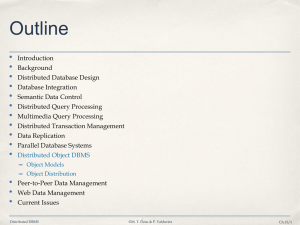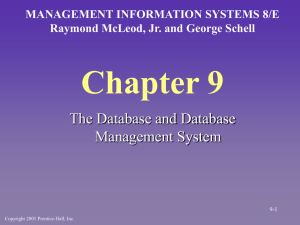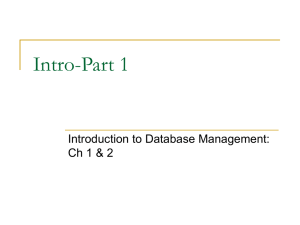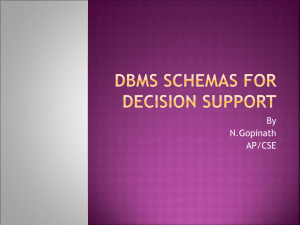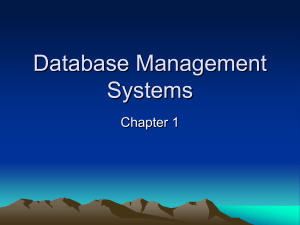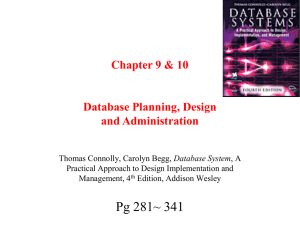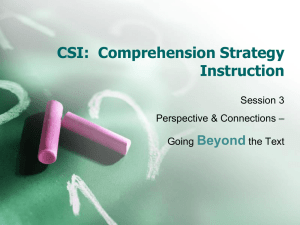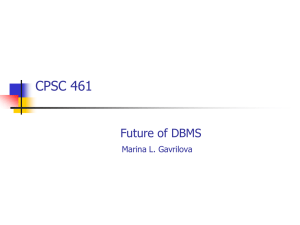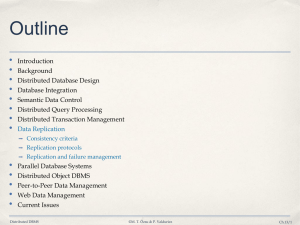4-Data Integrationx
advertisement
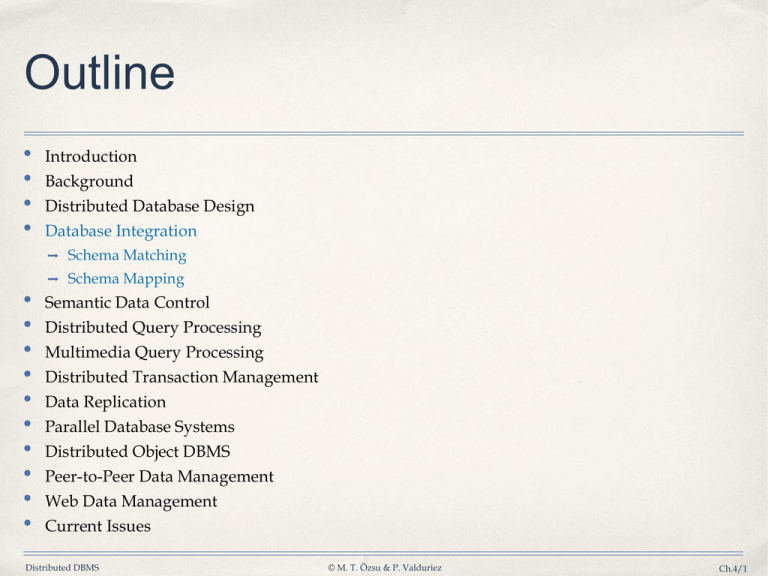
Outline • • • • Introduction Background Distributed Database Design Database Integration ➡ Schema Matching • • • • • • • • • • ➡ Schema Mapping Semantic Data Control Distributed Query Processing Multimedia Query Processing Distributed Transaction Management Data Replication Parallel Database Systems Distributed Object DBMS Peer-to-Peer Data Management Web Data Management Current Issues Distributed DBMS © M. T. Özsu & P. Valduriez Ch.4/1 Problem Definition • • Given existing databases with their Local Conceptual Schemas (LCSs), how to integrate the LCSs into a Global Conceptual Schema (GCS) ➡ GCS is also called mediated schema Bottom-up design process Distributed DBMS © M. T. Özsu & P. Valduriez Ch.4/2 Integration Alternatives • Physical integration ➡ Source databases integrated and the integrated database is materialized • ➡ Data warehouses Logical integration ➡ Global conceptual schema is virtual and not materialized ➡ Enterprise Information Integration (EII) Distributed DBMS © M. T. Özsu & P. Valduriez Ch.4/3 Data Warehouse Approach Distributed DBMS © M. T. Özsu & P. Valduriez Ch.4/4 Bottom-up Design • GCS (also called mediated schema) is defined first ➡ Map LCSs to this schema • ➡ As in data warehouses GCS is defined as an integration of parts of LCSs ➡ Generate GCS and map LCSs to this GCS Distributed DBMS © M. T. Özsu & P. Valduriez Ch.4/5 GCS/LCS Relationship • Local-as-view ➡ The GCS definition is assumed to exist, and each LCS is treated as a view • definition over it Global-as-view ➡ The GCS is defined as a set of views over the LCSs Distributed DBMS © M. T. Özsu & P. Valduriez Ch.4/6 Database Integration Process Distributed DBMS © M. T. Özsu & P. Valduriez Ch.4/7 Recall Access Architecture Distributed DBMS © M. T. Özsu & P. Valduriez Ch.4/8 Database Integration Issues • Schema translation ➡ Component database schemas translated to a common intermediate canonical • representation Schema generation ➡ Intermediate schemas are used to create a global conceptual schema Distributed DBMS © M. T. Özsu & P. Valduriez Ch.4/9 Schema Translation • What is the canonical data model? ➡ Relational ➡ Entity-relationship ✦ DIKE ➡ Object-oriented ✦ ARTEMIS ➡ Graph-oriented • ✦ DIPE, TranScm, COMA, Cupid ✦ Preferable with emergence of XML ✦ No common graph formalism Mapping algorithms ➡ These are well-known Distributed DBMS © M. T. Özsu & P. Valduriez Ch.4/10 Schema Generation • • • • Schema matching ➡ Finding the correspondences between multiple schemas Schema integration ➡ Creation of the GCS (or mediated schema) using the correspondences Schema mapping ➡ How to map data from local databases to the GCS Important: sometimes the GCS is defined first and schema matching and schema mapping is done against this target GCS Distributed DBMS © M. T. Özsu & P. Valduriez Ch.4/11 Running Example E-R Model Relational EMP(ENO, ENAME, TITLE) PROJ(PNO, PNAME, BUDGET, LOC, CNAME) ASG(ENO, PNO, RESP, DUR) PAY(TITLE, SAL) Distributed DBMS © M. T. Özsu & P. Valduriez Ch.4/12 Schema Matching • Schema heterogeneity ➡ Structural heterogeneity ✦ Type conflicts ✦ Dependency conflicts ✦ Key conflicts ✦ Behavioral conflicts ➡ Semantic heterogeneity ✦ More important and harder to deal with ✦ Synonyms, homonyms, hypernyms ✦ Different ontology ✦ Imprecise wording Distributed DBMS © M. T. Özsu & P. Valduriez Ch.4/13 Schema Matching (cont’d) • Other complications ➡ Insufficient schema and instance information ➡ Unavailability of schema documentation • ➡ Subjectivity of matching Issues that affect schema matching ➡ Schema versus instance matching ➡ Element versus structure level matching ➡ Matching cardinality Distributed DBMS © M. T. Özsu & P. Valduriez Ch.4/14 Schema Matching Approaches Distributed DBMS © M. T. Özsu & P. Valduriez Ch.4/15 Linguistic Schema Matching • • • Use element names and other textual information (textual descriptions, annotations) May use external sources (e.g., Thesauri) 〈SC1.element-1 ≈ SC2.element-2, p,s〉 ➡ Element-1 in schema SC1 is similar to element-2 in schema SC2 if predicate p • holds with a similarity value of s Schema level ➡ Deal with names of schema elements ➡ Handle cases such as synonyms, homonyms, hypernyms, data type • similarities Instance level ➡ Focus on information retrieval techniques (e.g., word frequencies, key terms) ➡ “Deduce” similarities from these Distributed DBMS © M. T. Özsu & P. Valduriez Ch.4/16 Linguistic Matchers • • Use a set of linguistic (terminological) rules • Predicate p and similarity value s Basic rules can be hand-crafted or may be discovered from outside sources (e.g., WordNet) ➡ hand-crafted ⇒ specified, • ➡ discovered ⇒ may be computed or specified by an expert after discovery Examples ➡ 〈uppercase names ≈ lower case names, true, 1.0〉 ➡ 〈uppercase names ≈ capitalized names, true, 1.0〉 ➡ 〈capitalized names ≈ lower case names, true, 1.0〉 ➡ 〈DB1.ASG ≈ DB2.WORKS_IN, true, 0.8〉 Distributed DBMS © M. T. Özsu & P. Valduriez Ch.4/17 Automatic Discovery of Name Similarities • • Affixes ➡ Common prefixes and suffixes between two element name strings N-grams ➡ Comparing how many substrings of length n are common between the two • name strings Edit distance ➡ Number of character modifications (additions, deletions, insertions) that • • needs to be performed to convert one string into the other Soundex code ➡ Phonetic similarity between names based on their soundex codes Also look at data types ➡ Data type similarity may suggest stronger relationship than the computed similarity using these methods or to differentiate between multiple strings with same value Distributed DBMS © M. T. Özsu & P. Valduriez Ch.4/18 N-gram Example • • 3-grams of string “Responsibility” are the following: Res sib ibi esp bip spo ili pon lit ons ity nsi 3-grams of string “Resp” are ➡ Res ➡ esp • 3-gram similarity: 2/12 = 0.17 Distributed DBMS © M. T. Özsu & P. Valduriez Ch.4/19 Edit Distance Example • • Again consider “Responsibility” and “Resp” To convert “Responsibility” to “Resp” ➡ Delete characters “o”, “n”, “s”, “i”, “b”, “i”, “l”, “i”, “t”, “y” • To convert “Resp” to “Responsibility” ➡ Add characters “o”, “n”, “s”, “i”, “b”, “i”, “l”, “i”, “t”, “y” • • The number of edit operations required is 10 Similarity is 1 − (10/14) = 0.29 Distributed DBMS © M. T. Özsu & P. Valduriez Ch.4/20 Constraint-based Matchers • Data always have constraints – use them ➡ Data type information ➡ Value ranges • ➡… Examples ➡ RESP and RESPONSIBILITY: n-gram similarity = 0.17, edit distance similarity = 0.19 (low) ➡ If they come from the same domain, this may increase their similarity value ➡ ENO in relational, WORKER.NUMBER and PROJECT.NUMBER in E-R ➡ ENO and WORKER.NUMBER may have type INTEGER while PROJECT.NUMBER may have STRING Distributed DBMS © M. T. Özsu & P. Valduriez Ch.4/21 Constraint-based Structural Matching • If two schema elements are structurally similar, then there is a higher likelihood that they represent the same concept • Structural similarity: ➡ Same properties (attributes) ➡ “Neighborhood” similarity ✦ Using graph representation ✦ The set of nodes that can be reached within a particular path length from a node are the neighbors of that node ✦ If two concepts (nodes) have similar set of neighbors, they are likely to represent the same concept Distributed DBMS © M. T. Özsu & P. Valduriez Ch.4/22 Learning-based Schema Matching • • Use machine learning techniques to determine schema matches • • Similarity is defined according to features of data instances Classification problem: classify concepts from various schemas into classes according to their similarity. Those that fall into the same class represent similar concepts Classification is “learned” from a training set Distributed DBMS © M. T. Özsu & P. Valduriez Ch.4/23 Learning-based Schema Matching Distributed DBMS © M. T. Özsu & P. Valduriez Ch.4/24 Combined Schema Matching Approaches • Use multiple matchers ➡ Each matcher focuses on one area (name, etc) • • Meta-matcher integrates these into one prediction Integration may be simple (take average of similarity values) or more complex (see Fagin’s work) Distributed DBMS © M. T. Özsu & P. Valduriez Ch.4/25 Schema Integration • • Use the correspondences to create a GCS Mainly a manual process, although rules can help Distributed DBMS © M. T. Özsu & P. Valduriez Ch.4/26 Binary Integration Methods Distributed DBMS © M. T. Özsu & P. Valduriez Ch.4/27 N-ary Integration Methods Distributed DBMS © M. T. Özsu & P. Valduriez Ch.4/28 Schema Mapping • Mapping data from each local database (source) to GCS (target) while preserving semantic consistency as defined in both source and target. • • Data warehouses ⇒ actual translation • • Mapping creation Data integration systems ⇒ discover mappings that can be used in the query processing phase Mapping maintenance Distributed DBMS © M. T. Özsu & P. Valduriez Ch.4/29 Mapping Creation Given ➡ A source LCS ➡ A target GCS ➡ A set of value correspondences discovered during schema matching phase Produce a set of queries that, when executed, will create GCS data instances from the source data. We are looking, for each Tk, a query Qk that is defined on a (possibly proper) subset of the relations in S such that, when executed, will generate data for Ti from the source relations Distributed DBMS © M. T. Özsu & P. Valduriez Ch.4/30 Mapping Creation Algorithm General idea: • • • Consider each Tk in turn. Divide Vk into subsets such that each specifies one possible way that values of Tk can be computed. Each can be mapped to a query some of Tk’s data. that, when executed, would generate Union of these queries gives Distributed DBMS © M. T. Özsu & P. Valduriez Ch.4/31
